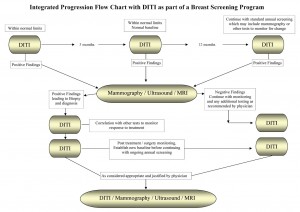By Peter Leando, PhD. DSc. DAc. Fellow, Royal Society of Medicine; Fellow, American College of Clinical Thermology –


It takes years for most cancers to develop to the state that they can be detected with mammogram or ultrasound, meaning they are dense enough for location and biopsy. DITI is ideally placed as a screening tool to identify changes over time in the early developmental stages before there is more advanced pathology that can be detected with other tests.
The Benefit of Early Detection
The major benefit in this group is in detecting early changes that precede malignant pathology that will become diagnosable at some stage. Early detection is aimed at prevention and if early changes are detected, then there is an opportunity to intervene and change the outcome. The earlier an abnormality is detected the better the treatment options will be, resulting in a better outcome. Prevention may include treatment of inflammation, fibrocystic disease, lymph congestion, estrogen dominance and more specific conditions like angiogenesis.
DITI is Different than Mammogram or Ultrasound
DITI does not provide any of the same findings or information that mammogram or ultrasound provides; it is a different type of test. DITI shows information relating to vascular activity, inflammation, lymphatic activity, hormonal dysfunction and other functional abnormalities. There are no contraindications for DITI. It is totally non-invasive, no radiation of any type and no contact with the body so it can “do no harm.”
Mammogram and ultrasound show structure. Tissue densities can be evaluated, lumps can be measured, calcifications located and opinions given regarding pathology before biopsy; none of which DITI can provide. There is no comparison or competition between mammogram and DITI. They are two different screenings providing different results.
Results from a thermogram are reported by medical doctors who are certified thermologists and experienced in reading thermograms. The interpreting doctors take into consideration all history and symptoms as well as the results of other tests.
DITI Benefits for Patients Over Age 50
In patients of mammographic age (generally over 50), post menopause or when the density of breast tissue has reduced sufficiently to make mammography more effective, DITI not only provides the benefit of early detection of functional change but can also increase the detection rates of other tests by contributing additional information about functional or physiological abnormalities and also the location of suspicious or positive thermal findings that may be outside the range of other tests due to the location, size of breast, implant or other limiting factors.
DITI as a screening test in all age groups is designed to establish a baseline, or the individual’s normal thermal fingerprint, for ongoing comparative analysis, usually done annually, to detect any physiological change that justifies additional testing. This could include a physician exam, mammogram, ultrasound, MRI, blood work, hormone testing or a number of other interventions.
Changes DITI Can Detect
The changes that DITI can detect include inflammatory pathology (inflammatory carcinoma/inflammatory breast disease), infection, lymph dysfunction (lymph congestion, lymph node pathology), vascular changes (development of new and abnormal blood vessels known as angiogenesis), and also any suspicious activity outside the range or scope of other tests (outside the border of the breast, in the sternum or axilla). So again, there is no comparison or competition between different tests.
DITI cannot detect specific pathology like a biopsy; it cannot detect tumors or micro-calcifications. DITI cannot “see” structure. It would be unfortunate for a patient to forgo a necessary mammogram that was justified, and any decision should be made with the consultation between the patient and her doctors based on individual history, symptoms and test results. DITI does have the potential to create anxiety for a patient, as does a mammogram, with equivocal results or results that cannot be confirmed or positively diagnosed. Both tests can minimize unnecessary anxiety with better informed consent, education and a realistic expectation for the test. The best possible plan is to use every appropriate test adjunctively to get the highest detection rates without generating additional or unnecessary invasive testing.
To Learn More
To further understand the role of DITI in Breast Screening, please call Southwest Medical Thermal Imaging at 239-949-2011 or visit us online at www.thermalclinic.org.
 Southwest Florida's Health and Wellness Magazine Health and Wellness Articles
Southwest Florida's Health and Wellness Magazine Health and Wellness Articles
